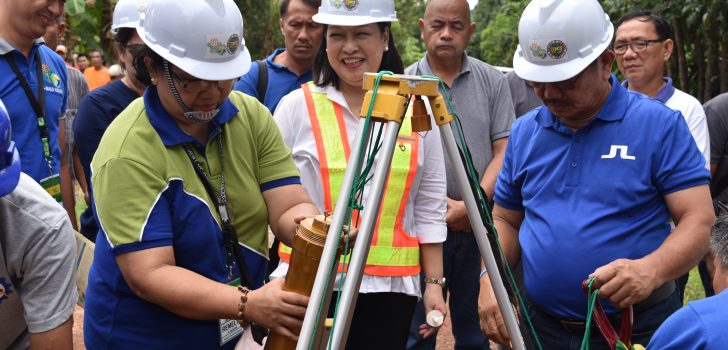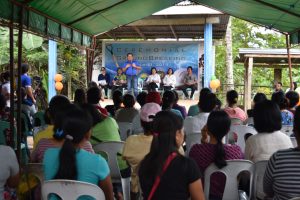 Agriculture secretary Emmanuel F. Piñol (right); Remelyn R. Recoter, Visayas Project Support Office director (left); and Guimaras congressman Lucille Nava (middle) lead the groundbreaking of the 10.87-kilometer Bugnay-Sapal-Maabay farm-to-market road in San Lorenzo, Guimaras. (Photo by John Paul Firmalino Cadiz, RPCO 6 InfoACE)
Agriculture secretary Emmanuel F. Piñol (right); Remelyn R. Recoter, Visayas Project Support Office director (left); and Guimaras congressman Lucille Nava (middle) lead the groundbreaking of the 10.87-kilometer Bugnay-Sapal-Maabay farm-to-market road in San Lorenzo, Guimaras. (Photo by John Paul Firmalino Cadiz, RPCO 6 InfoACE) 10-kilometer FMR to ease burdens of Guimaras farmers
For the 77-year-old Salvadora Talagon of Sitio Curipao, Barangay Constancia, San Lorenzo, Guimaras, the P130 million-worth, 10.87-kilometer farm-to-market road (FMR) is heaven’s answer to their longtime prayer.
“One can only imagine how hard it is for us to transport our produce because of the condition of the roads here,” said Talagon. “Double the struggle during the rainy season when the roads get muddy.”
By mid-2018, Talagon’s and many other Guimarasnon farmers’ lives will become better once the 10.87-kilometer FMR, an infrastructure subproject of the Department of Agriculture’s Philippine Rural Development Project (DA-PRDP) and the provincial government of Guimaras, is completed.
The subproject rehabilitation/concreting of Bugnay-Sapal-Maabay FMR that costs P130,124,660.91 will cover four barangays in three municipalities: Bugnay in Jordan; Constancia and Sapal in San Lorenzo; and Maabay in Sibunag. It will also indirectly benefit at least 10 barangays in four municipalities: Piña, Gaban, Tamborong and Sebario in San Lorenzo; Agsanayan and Tinadtaran in Buenavista; Alaguisoc in Jordan; and Millan, Tanglad and Ayangan in Sibunag.
Agriculture secretary Emmanuel F. Piñol, who was one of the key people behind the Mindanao Rural Development Project from which the DA-PRDP was patterned, said the road has an impact on the lives of the farmers.
“Magabag-o ang kabuhi sang mga mangunguma diri (The lives of the farmers who live here will change), Piñol said during the groundbreaking of the subproject. “Roads play an important role in development. What good will the produce be without good roads? In countryside development, there should be a link between the roads and the enterprise. And that is what the [DA] PRDP is doing.”

Secretary Emmanuel F. Piñol encourages the beneficiaries of the 10.87-kilometer farm-to-market road to monitor the status of the subproject to promote transparency and accountability. (Photo by John Paul Firmalino Cadiz, RPCO 6 InfoACE)
Meanwhile, some 26,634 Guimarasnon farmers who are engaged in mango, rice, corn, coconut, and sweet potato production will benefit from the FMR.
“Most of us are looking forward to the completion of the FMR. By then, transporting our products will be easier and faster,” said the 61-year-old Emily Templador of Sitio Balayong, Barangay Constancia, San Lorenzo town.
Templador said that currently, there is only one jeepney trip in their area because of the condition of the roads.
“The jeepney leaves at 2 a.m. Most of the time for many of us, we need to leave our houses earlier because we still need to load our products to a cart and bring them to the roadside. If we miss the 2 a.m. trip, then we look for other means to bring our products to the market,” said Templador.
With the current road condition, the trip by jeepney takes one hour and a half. By habal–habal (single motorcycle), the trip takes almost two hours.
“We can opt to ride a habal–habal that charges P60 per passenger, and P20 per sack or carton,” said the 75-year-old Gregoria Animas, also from Sitio Curipao. “But this is very hard because we need to carry our cargo by both hands, and sometimes on our heads.”
The habal–habal has a different rate when they transport swine, cattle, goat, or chicken, Animas said. The transport cost is P2 per kilo. Hence, the farmers said their earnings from selling their products in the market are sometimes not enough for their fare and transport cost.
On the other hand, Manuel O. Olanday, deputy project director of the DA-PRDP’s Regional Project Coordination Office 6, said the FMR is vital in the agro-economic activity in the area because it will connect north and south Guimaras.
“The farmers will benefit from the subproject because it is seen to reduce by 15 percent their travel time from the production areas to the market. Lesser travel time translates to lower spoilage when they transport their produce—lower by three percent,” said Olanday.
The project will benefit producers, traders, and the rural population in general, he stressed. Since Guimaras is into mango and rice production, Olanday said the FMR will be most beneficial to the farmers because it will reduce by as much as 40 percent the hauling cost of these products. It will also reduce the hauling of farm inputs by at least 20 percent.
In addition, it will be a big boost to Guimaras’ livestock industry, he said. The province is a major source of native chicken, goat and cattle that are supplied in Iloilo City.
“The FMR is also seen to increase the volume of traffic along its road influence area. This means that it can spur other activities in these barangays. For example, some residents can put up sari–sari stores to augment the family’s income, while the schoolchildren will have a faster and easier travel to and from school,” said Olanday. (John Paul Firmalino Cadiz, RPCO 6 InfoACE, Writer)
